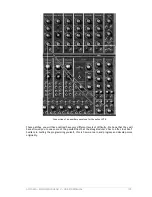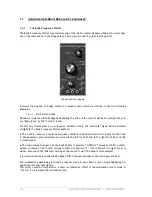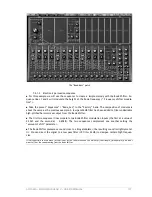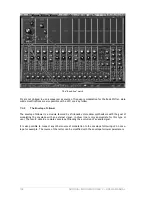
ARTURIA – MOOG MODULAR V – USER’S MANUAL
149
which you had modified the parameters (without having saved them under the name “P2”), the next
time the song is opened, the Moog Modular V will load preset “P1” with the modifications.
The drop down menu offered by the VST sequencer to save plug-in settings can of course be used
with the Moog Modular V. Nevertheless, it is strongly recommended that you use the internal Moog
Modular V menu: the presets saved in this manner can be used in any other mode (standalone or
other sequencer), and can be exported as a unique file.
8.2.5 Automation
Automation works with the Moog Modular V as like any other VST plug-in (refer tot he VST sequencer
documentation for more information on the automation of plug-ins). Preset changing (and therefore
cable changing) cannot be automated.
8.3 PRO
TOOLS™
8.3.1 Installation
During the initial installation, select Install as a RTAS/HTDM plug-in.
Then, when you are asked, indicate the folder in which the other RTAS and HTDM plug-ins are pla-
ced. Generally the path is:
•
for Mac OS 9: System Folder/DAE Folder/Plug-Ins
•
for Windows: C:\Program Files\Digidesign\DAE\Plug-Ins
If your system can or cannot use the HTDM plug-ins or not (see the next section), the installation is
the same.
Under Mac OS 9, you need to increase the memory attributed to DAE (see the Pro Tools manual for
the procedure) by 15 mega bytes.
8.3.2
The RTAS and HTDM standards
The Moog Modular V can function with the audio Digidesign motor (DAE) in two ways:
•
As a RTAS plug-in (Real Time Audio Suite).
All of the Pro Tools systems are compatible with this standard: the audio treatment is realized en-
tirely by the central unit, and does not require any specific extension card (TDM system type). On
the TDM systems, the RTAS plug-ins can only be loaded on an audio track before the TDM plug-ins.
They can only be loaded on an Aux Input or a Master Fader.
•
As a HTDM plug-in (Host Time Division Multiplexing).
Only the TDM systems (with at least one extension card) under Mac OS Classic and X can use these
plug-ins (refer to Digidesign for the future HTDM compatibility with Windows). The latter work ex-
actly like TDM plug-ins (no limitations in the insertion positions, etc…), with the difference that in
this case, the heart of the treatment is realized by the central unit, and not by the extension cards.
The advantage of this standard is the subtlety of TDM, and this, loading at least the DSP of the
cards.
Recap on the compatibilities:
Mac OS 9 and X
Windows 98/2000/XP
TDM System
RTAS and HTDM
(stereo in/stereo out)
RTAS
(stereo in/stereo out)
Other Systems
(Pro Tools LE, Free)
RTAS (mono in/stereo out and
stereo in/stereo out)
RTAS (mono in/stereo out and
stereo in/stereo out)
Summary of Contents for Moog Modular V
Page 1: ...USER S MANUAL Moog Modular V 2 ...
Page 4: ......
Page 8: ......
Page 18: ...18 ARTURIA MOOG MODULAR V USER S MANUAL ...
Page 52: ...52 ARTURIA MOOG MODULAR V USER S MANUAL ...
Page 85: ...ARTURIA MOOG MODULAR V USER S MANUAL 85 Independent mode Parallel mode Serial mode ...
Page 102: ...102 ARTURIA MOOG MODULAR V USER S MANUAL ...







































